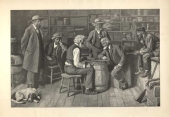The Checker Maven
The World's Most Widely Read Checkers and Draughts Publication
Bob Newell, Editor-in-Chief
Published every Saturday morning in Honolulu, Hawai`i
Noticing missing images? An explanation is here.
Software Upgrade

In order to serve you better, we've upgraded the software (Nucleus CMS) that we use to run our site. After a few moments of bug-fixing panic, everything now looks fine from our end, but if you experience any problems please help out by letting us know. You can reach us at webmaster@checkermaven.com.
By the way, we can't help but take this opportunity to editorialize a bit. The Checker Maven relies greatly upon free, open-source software (often abbreviated as FOSS) such as Nucleus CMS. We hope you'll join us in supporting the FOSS movement.
![]()
Marvin Visits Manchester

It was the All-Star break during this year's National Checker League season, and as part of the week-long festivities, Marvin J. Mavin, checker star and team captain of the Detroit Doublejumpers, was doing a promotional tour in Great Britain.

Professional Checker Star Marvin J. Mavin
Certainly it would come as no surprise to know that one of the stops on Marvin's tour was the city of Manchester, truly one of the checker--- or should we say draughts--- capitols of England. Marvin had undertaken to play a simultaneous exhibition against the members of the British Amateur Championship team, the Chorley Checker Chaps. A fivesome made up of star draughtmen, their roster was impressive: Matthew Eek; the eminent mathematician and team captain Dr. John Algeeber; Donald Oligarch; Melvyn Emerald; and Eddie O'Gollie.

The Championship Team, The Chorley Checker Chaps
The match was taking place at that noted local enterprise, the Multicorn, where it was said that the beer and ale were of the highest quality and the atmosphere most suited for a serious match of draughts.

The Multicorn, Site of the Match
When told of the arrangements, we understand that Marvin approved wholeheartedly, even though his coach had warned him to maintain a positive image and keep in mind the public relations purpose of the tour: in other words, keep away from the beer, stay sober, and play winning checkers.
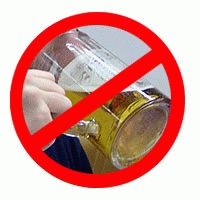
There were a couple of problems with that directive, however. First, Marvin, being more than a bit of an iconoclast, always had shall we say a bit of a problem in following the directions of higher authorities. Second, as we all unfortunately know, Marvin was rather partial to a good pint of beer, and was known to partake at inappropriate moments, and in fact at any moment possible. (Recall our earlier Checker Maven story in which Marvin lost a game to his arch-rival, Dmitri Tovarischky, after having enjoyed Octoberfest beverages a little too freely.)
Marvin was in full form for today's exhibition, and he would need to be at his best; the Checker Chaps were no easy targets, being the best amateur players in England. The playing room was ready; the Checker Chaps were seated at their boards, and the room was filled to overflowing with enthusastic fans.
The match was about to begin when to everyone's surprise (or perhaps to no one's), Marvin suddenly called for "a pint of Base Ale all around."
The Checker Chaps did their best to mutter polite refusals but not a few of the fans, and Marvin himself, soon had in hand a frothy mug of ale. Play began, and it quickly became evident that the Checker Chaps would provide Marvin with stiff competition.
Marvin quickly won his game on Board 4 after taking advantage of a positional error. Board 5 ran into a quick draw, as did Board 3. On Board 2, Marvin lost a piece in a tricky exchange and graciously (at least by Marvin's standards) resigned the game, quickly calling for another pint of Base Ale to assuage his disappointment with the loss.
The game on Board 1 with Dr. Algeeber would decide the match. It had played out thus far as follows:
Black: Marvin J. Mavin
White: Dr. John Algeeber
| 1. | 9-14 | 24-20 |
| 2. | 5-9 | 22-18 |
| 3. | 11-15 | 18x11 |
| 4. | 8x15 | 25-22 |
| 5. | 7-11 | 22-17 |
| 6. | 4-8 | 17-13 |
| 7. | 2-7 | 29-25 |
| 8. | 1-5---diagram |
The situation was tense. Dr. Algeeber wanted to win the game and take the match on behalf of his team and the home town fans. Marvin, of course, as a star professional player, had a reputation to uphold. But Dr. Algeeber was an expert in his own right and an opponent not to be taken lightly.
Of course, one had to ask if Marvin should really have called for that third pint of Base Ale, "to clarify his thinking" as he told the barmaid.

Dr. Algeeber had again declined, this time noting in a somewhat pointed manner that "draughts of ale and draughts over the board really don't mix all that well, you know." The British team captain was now on move, and realized that he had chances to perhaps pull through with a win. The board position was as follows.
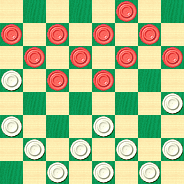
WHITE
White to Play and Win
W:W32,31,30,28,27,26,25,23,21,20,13:B15,14,12,11,10,9,8,7,6,5,3.
Marvin, as usual, was fidgeting in his chair, taking frequent sips from his mug. Though he found this all more than a bit annoying and distracting, Dr. Algeeber, being the gentleman that he was, refrained from complaining. Finally, though, he allowed himself a bit of a smile as he made his move.
Would you have been able to win this position against someone with Marvin's finely honed professional skills? Would you have been able to keep cool despite Marvin's constant fidgeting, muttering, and slurping of ale, or would you have been tempted to dump a water pitcher over his head?
Well, we certainly wouldn't recommend something so impolitic as the latter, but we do recommend that you try to find the winning move, and then click on Read More for the conclusion of the story and the solution to our problem.![]()
A Study In Structure

In this month's excerpt from Willie Ryan's unmatchable Tricks Traps & Shots of the Checkerboard, we see a situation that Willie characterizes as "not so impressive as most of the other items." Of course, Willie has extremely high standards, but we can certainly say that we're impressed with this little gem! Add in the fact that it is of practical use, and you have something that certainly ought to command our attention. Here's Willie to explain it all to us.
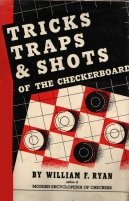
"The following stroke theme is not so impressive as most of the other items in my compendium, but it is one of major importance, and of a type most likely to be overlooked in crossboard play. The game itself was adapted from one I played with 15-year-old Leonard Rosenfield, of Boston, who has all the promise of a future World Champion.
| 9-13 | 15-18 | 6-15 |
| 24-20 | 28-24 | 32-28 |
| 6- 9 | 11-15 | 12-16---A |
| 22-18 | 26-23 | 30-26 |
| 10-15 | 8-11 | 16-19---C, |
| 18-14 | 23-19 | forming the |
| 9-18 | 2- 6 | diagram. |
| 23-14 | 19-10 |
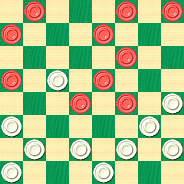
WHITE
White to Play and Win
W:W14,20,21,24,25,26,27,28,29,31:B1,3,4,5,7,11,13,15,18,19.
A---If 4-8 is moved, follow with 30-26* (not 24-19,15-24, 28-19, 11-15, 19-10, 18-22, 25-18, 5-9, shot), 12-16---B, 26-23, 8-12, 25-22*, 18-25, 29-22, 16-19, 23-16, 12-19, 22-18* (not 31-26, 1-6, 14-10, 7-14, 27-23, 14-18*, 23-14, 6-9, 14-10, 9-14, etc., black wins), 15-22, 24-8, 3-12, 27-24, 1-6, 20-16, 12-19, 24-15, 22-25, 28-24, 25-30, 24-19, 30-25, 31-27*, 25-22, 27-24, etc., ending in a draw. Leonard Rosenfield vs. Wm. F. Ryan.
B---18-22, 25-18, 15-22, 26-17, 13-22, 27-23, 11-15, 23-18, 8-11, 24-19, 15-24, 28-19, 1-6, 19-15, 22-26, 31-22, 7-10, 14-7, 3-19, 29-25, etc., accomplishes a draw. Wm. F. Ryan.
C---Down the wrong alley! The correct thrust is 4-8, 26-23, 8-12, making the draw play shown in Note A."
Can you structure a solution, or is your thinking perhaps too rigid? Clicking on Read More is a predictable part of our weekly structure, and you know that it will bring you straight to the solution, and an interesting computer addition to Willie's original analysis.![]()
Small, Square, Two Inches of Ivory

The famous British novelist of the late 18th and early 19th century, Jane Austen, spoke of her writer's canvas as a "small, square, two inches of ivory." By this she seemed to have meant that her works were limited in scope and in some sense "miniatures" based on the society in which she lived.
But this is a checker column, not a literary review, and we bring up Miss Austen only as a point of comparison to miniatures in checkers. They too deliberately limit their scope, but, like Jane Austen's famed novels, have no lack of intricacy, depth, and ultimately, charm.
Today we publish a Checker School study taken from the pages of Ben Boland's Famous Positions in the Game of Checkers. It's indeed a small square of ivory with much appeal and value. Here's the position.
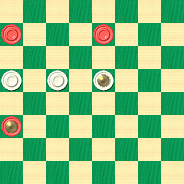
WHITE
White to Play and Draw
W:W13,14,K15:B5,7,K21.
Can you find the White draw in this deceptively simple setting? You needn't be a Victorian gentleman or lady to find the answer; pure skill at checkers is what's required. When you've arrived at your solution, click Read More for the correct procedure accompanied not by harpischord or pianoforte, but instead a trio of sample games and extensive explanatory notes.![]()
Send in the Marines

When a rapid response is needed in times of crisis, we often hear the expression, "Send in the Marines!" And indeed, the United States Marines are renowned for their ability and willingness to take on tough problems and solve them quickly.
This month's speed problem doesn't require a rapid response force of the military kind, but does indeed require quick wits and checker skill. It's a problem that mid-20th century checker great Millard Hopper demonstrated to members of the United States Marines while Mr. Hopper was on a USO tour during World War II. The Marines learned to solve it; can you?
Ten seconds on our Javascript clock is all we're giving you, so snap to attention and take off at double time!
June Speed Problem (easy)
Check your solution by clicking on Read More, and that's an order, checker player!![]()
Uncle Ben's Porch: Tommy's Tryout

It was getting near the end of the school year. Tommy had done well and had kept up his grades, and so Mom had allowed him to continue to spend a couple of hours every Saturday morning over on Uncle Ben's porch, learning checker lore from the old retired gentleman, who had won much-justified fame and recognition in an earlier year as a checker author, teacher, and master player.

"Well, Tommy," Uncle Ben said as they had settled into their chairs on another hot and steamy Florida morning, "pretty soon there will be the Elementary School Varsity Checker Team tryouts."
"Yes, Uncle Ben," Tommy replied, "I'm eligible for the team next year, and the tryouts take place just before the end of this year." (Of course, Uncle Ben wasn't really Tommy's uncle, but everyone called him that.) "I'm going to do my best to make the team," Tommy added.
"Well, Tommy, you've been coming right along," Uncle Ben said, "but of course your school has one of the top teams and it's going to be tough competition to win a team spot." Uncle Ben paused and reflected for a moment. "Now I know you're probably the best player in your class, but it's quite rare for someone to make Varsity the very first year that they're eligible. So it just might happen that you would have to play Junior Varsity for a season or two."
Tommy knew that Uncle Ben was trying, in his own kind and gentle way, to tell him not to be disappointed if he didn't make the team on his first try. Tommy understood just how hard that might be. But didn't Uncle Ben know just how badly Tommy wanted to make the team? After all, he'd been working on his checkers really hard this past year, paying close attention to everything that Uncle Ben taught him each Saturday morning. And besides, he'd made a point of keeping up his grades, skipping all of his favorite weeknight television programs in order to have enough time to do really good schoolwork.
Uncle Ben winked at Tommy, He did that often, but it still always caught Tommy by surprise. Uncle Ben always seemed to know just when to lighten the mood, offer a glass of his delicious homemade lemonade, or just the right word of encouragement. He really was a special kind of grownup.
"Oh yes, Tommy, I do know what you're thinking, and you have indeed turned into a fine young checkerist. But some things just take time. The wood in these fine old chairs we're sitting on didn't get seasoned over night. Some things just take time and waiting and patience. That's often hard for a young fellow to understand, but you'll see it all in time. So do your best, and whether you make the Varsity team now or a little later, I'll still be very proud of you and all that you've learned."

Before you could know it, the lemonade glasses were filled to the brim, and Uncle Ben had turned to the checkerboard, which as usual was set up with the day's work. "So, Tommy, I've got one for you here," Uncle Ben said. "It's something that will come up often in your games and who knows, you might even see it in your tryouts. Take a look."

Well, Tommy thought, Uncle Ben is hardly ever wrong--- he couldn't remember a single time, in fact, that Uncle Ben hadn't taught just the right thing at just the right time. Tommy sipped the cool, refreshing lemonade while he looked over the position Uncle Ben had laid out.
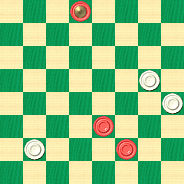
BLACK
Black to Play and Win
B:W17,13,8:BK31,10,6.
As usual, it didn't look easy at all, but Tommy knew that Uncle Ben was always giving him something that would stretch and grow his skills while still staying within his grasp... if he would just work at it hard enough. This time, Tommy was through most of his glass of lemonade before the idea came to him, and as he always did, said, "Hey Uncle Ben, how about this...." and started to move the pieces.
Can you solve the position? Whether or not you played Varsity Checkers for your school, give it a try and then click on Read More for the solution, a sample game, and no less than twenty additional examples of this theme.![]()
Computer-Aided Checker Instruction

Editor's Note, January 2025: The software discussed here is no longer available and has not been for many years. The website is off the air as well.
In the world of chess, computer aids to learning are ubiquitous; virtually every chess vendor offers a bewilderingly extensive line of products, from problem collections to video tutorials to opening book trainers. Numerous other board games offer at least a few products to help build your expertise or perfect your skills. But in the world of checkers, you'd be hard pressed to find anything even remotely similar to the wide variety of choices available for other games.
However, there is an option, and checkerist Al Lyman has been working on it and refining it for a number of years. In its latest form, it's called Straight Checkers Gold and can be found at Al's Checkerworld site. Combining the original "Straight Checkers" program with two "mini" tutorial programs, the package currently sells for $59. A supplement called Formations is available for an additional $39.
Our purpose today isn't to promote Al's packages, or even to do a complete review; instead, we'd like to showcase a sample problem from each of his offerings and let you see for yourself. To our knowledge, there are no other even slightly serious computer-based checker training programs available anywhere else in the world, so in that respect, the Straight Checkers series is unique indeed.
Straight Checkers Gold consists of numerous modules and lessons, as shown in the screenshot below (click on the picture for a full-size version).
The modules and lessons can be studied in any order; there is no particular sequence or syllabus. Here is an example taken from the "sight solver" section, a grouping of 18 moderately easy problems.
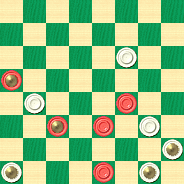
BLACK
Black to Play and Win
B:W22,16,9,K5,K4,K1:BK20,14,K11,10,2.
The additional Formations package proposes additional lessons about common checker patterns and formations, but quite a bit more is provided. Again, you can click on the screenshot below for a full-size version.
Here's an example position demonstrated in the tutorial, from the Wilderness run-up:
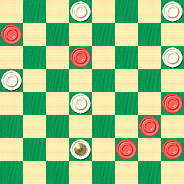
BLACK
Black to Play and Draw
B:W31,29,21,20,15,K7:B28,23,13,9,6,5.
As we said, we're not attempting a review of Al's packages. A demo version is available on Al's website, and you're best advised to take a look and see what you think. We can say, however, that there is truly nothing else like these programs to be found anywhere!
Click on Read More for the solutions to the problems above.![]()
Reed's Rattler

While the rattler similar to the one shown above can often be seen in the countryside near our Santa Fe offices, in this month's chapter of Willie Ryan's Tricks Traps & Shots of the Checkerboard, we're talking about a different kind of rattler; namely, a position that leaves you feeling, well, rattled. And, in Willie's example, who better to be the "rattlee" than that checker pedantic of yore, Harvey L. Hopkins, who, based on his writing, certainly seemed to be more than a little on the stodgy side. We can just imagine him becoming rattled indeed in the very odd position which arises below. Of course, Willie's remarks on "Chop Suey Checkers" and "Chinese checker games" might not pass muster in today's environment of political correctness, but we hope you'll allow the allusions; they're rather colorful and certainly well intended.
And now, here's Willie.

"Old-timers say that Champion James P. Reed was unbeatable when he was sober. His uncanny ability to penetrate the possibilities of play in complicated situations won him the distinction of being the greatest crossboard player of his day. Reed's main dish was 'Chop Suey Checkers,' a term he used to describe positions in which the pieces became entangled in complete confusion. The game below shows what happened to Harvey L. Hopkins, of Chicago, when Reed caught him in one of his Chinese checker games many years ago."
| 11-16 | 18-15 | 10-14 |
| 24-20 | 5-9 | 27-24 |
| 16-19 | 25-22 | 18-23 |
| 23-16 | 9-14 | 22-18---B |
| 12-19 | 29-25 | See the |
| 22-18 | 14-18 | diagram. |
| 9-13---A | 20-16 |
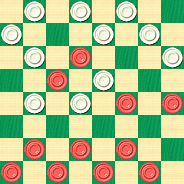
BLACK
Black to Play and Win
B:W32,31,30,28,26,25,24,21,18,16,15:B23,19,14,13,8,7,6,4,3,2,1.
A---This enigmatic move was a great favorite with Mr. Reed, and one which led opponents into a maze of complicated formations so dense that even seasoned masters often became hopelessly lost in their kaleidoscopic patterns.
B---It should be noted that 31-27 also loses here, by 6-9, 27-18,14-23,15-10 (forced), 7-14, 24-15, 23-27, 32-23, 8-11,15-8,4-20, 22-18,1-5, etc., and black wins. Wm. F. Ryan. White's best move at B is 24-20, then 7-10*---C, 16-12---D, 14-18, 21-17, 2-7, 28-24, 19-28, 26-19, 18-23, 25-21 (31-27, 23-26, 30-23, 7-11, 20-16*, 11-20,*, 23-18*, 8-11, etc., a draw), 8-11, 15-8, 4-11, 15-8, 4-11, 19-16, 11-15, 16-11, 7-16, 20-11, 15-18, 22-15, 13-22, 31-27, 10-19, 27-18, 19-23, leading to a draw. Wm. F. Ryan.
C---If 14-18 is used, white will win with 16-11*, 7-16, 20-11, 6-10 (forced; if 1-5, then 31-27, 19-24, 27-20), 15-6, 8-15, 21-17*, 1-10, 17-14, 10-17, 28-24, 19-28, 26-10, 17-26, 30-14, 13-17, 25-22, 18-25, 29-22, 4-8, 14-9. Wm. F. Ryan.
D---If 22-18 is used, then the following moves will produce a draw: 1-5, 18-9, 5-14, 31-27, 14-18, 16-12, 2-7 (8-11 draws too), 15-11, 7-16, 20-11, 8-15, 25-22, 18-25, 27-11, 10-15, 32-27, 6-10, 11-7, 13-17, 21-14, 10-17, 30-14, 3-17, 27-23, 17-22. Wm. F. Ryan. Again at D, if 16-11 is used, black will win with 14-18, 21-17, 1-5*, 20-16, 8-12, 31-27, 3-8, 27-24, 5-9, 24-20, 9-14."
Can you make your way through this one without getting rattled yourself? No need to hiss; just click on Read More to slither over to the solution.![]()
A Checker Hutzler

We're not personally acquainted with any modern-day checker analogue to the traditional pool hustler, but we know for sure that, at least in times past, such a thing did in fact exist, and no doubt exists somewhere today. Old Bennie Newell himself (your editor's grandfather) hustled checkers in his tavern in Newark, New Jersey, many decades ago, and there certainly were many others.
We don't know if the author of today's problem, a checkerist of yore named Henry Hutzler, was a hustler in anything but homonymous surname, but his composition makes a fitting entry for our Checker School series. It's deceptively simple, though not as hard as some others, and most of all, it's eminently practical and it or its like turns up in many an over-the-board contest.
BLACK
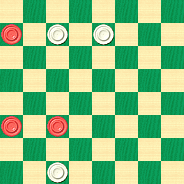
WHITE
White to Play and Win
W:W6,7,30:B5,21,22.
Forces are even, but White has a recognizable positional advantage. Is it enough to win? Mr. Hutlzer says it is, and no doubt he would have been willing to bet on it. What do you say? Make your call and then prove it before clicking on Read More to see the solution, a sample game, explanatory notes, and a most interesting quotation.![]()
Block Construction

This month, instead of the usual speed problem or stroke problem which is our traditional month opener, we're bringing you an example of a rarer species: the block problem. And this is not just any block problem; it's a block construction problem.
Having nothing at all to do with the building trades, a block construction problem challenges you to reconstruct the moves leading up to a block position. Let's take a closer look: our target position is shown below.
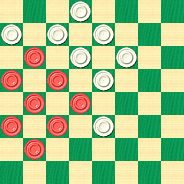
BLACK
Black to Play; White has Won
B:W31,28,27,26,23,22,18,10:B24,20,19,16,15,12,11,8.
In this position, Black is to move and the game is lost. Black is completely blocked and has no move. Your challenge is to come up with a full game, composed only of legal moves, that will lead to the block position shown. This is much more difficult than you might think, and could take an expert player an hour or more to do.
Are you up to the challenge, or are your mental processes blocked? Show your prowess as a builder by solving today's problem, then click on Read More to see how our position arose in an actual published game.![]()
The Checker Maven is produced at editorial offices in Honolulu, Hawai`i, as a completely non-commercial public service from which no profit is obtained or sought. Original material is Copyright © 2004-2025 Avi Gobbler Publishing. Other material is public domain, as attributed, or licensed under Creative Commons. Information presented on this site is offered as-is, at no cost, and bears no express or implied warranty as to accuracy or usability. You agree that you use such information entirely at your own risk. No liabilities of any kind under any legal theory whatsoever are accepted. The Checker Maven is dedicated to the memory of Mr. Bob Newell, Sr.



